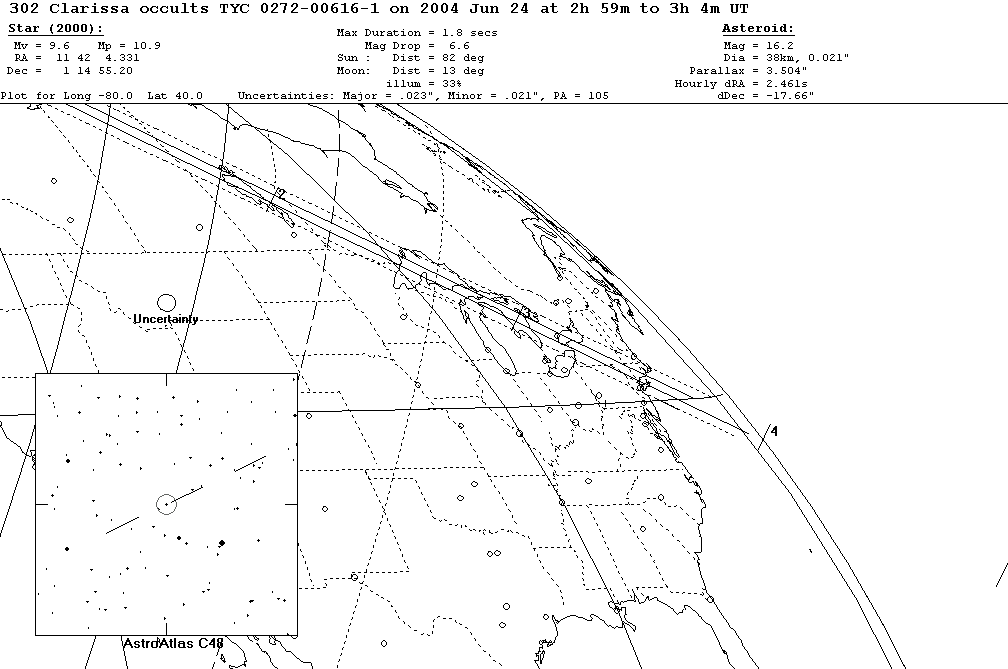
Map courtesy of Steve Preston -- see the Asteroid Occultation Update page for upcoming events.
On the night of June 23/24, 2004, the asteroid (302) Clarissa was predicted to occult the star TYC 0272-00616-1 for observers in the northeast US and central Canada.

Map courtesy of Steve Preston -- see
the Asteroid Occultation Update page
for upcoming events.
At the RIT Observatory near Rochester, New York,
My setup was:
The star was only 18 degrees above the western horizon at the time of the event, at airmass 3.2. I worried that we would not be able to detect the star, which has Tycho magnitudes Bt=11.2 and Vt=9.7. The star was easily visible through a 28-mm eyepiece, as was the somewhat fainter star to its southeast (Bt=11.5, Vt=11.0).
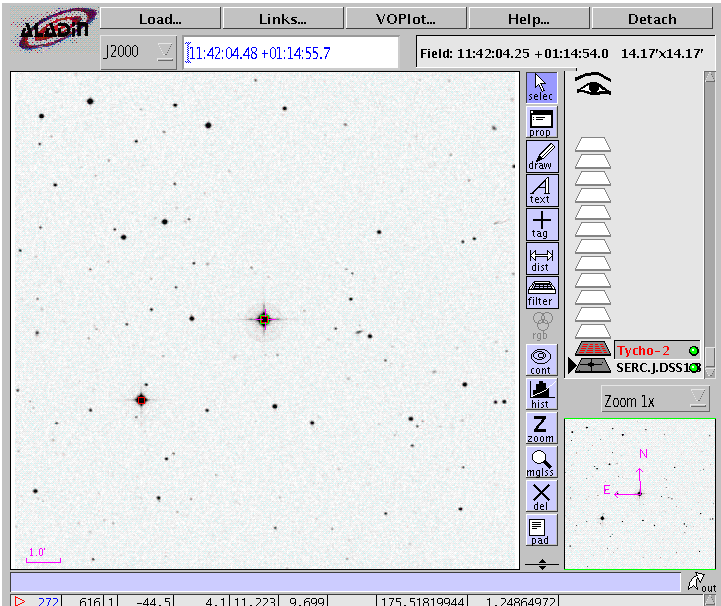
The video camera has a very small field of view, but we managed to find the target star by first centering it in an eyepiece and then swapping eyepiece for camera. The signal level wasn't very high, though, and even at the best focus position, the star was more of a blob than a point:
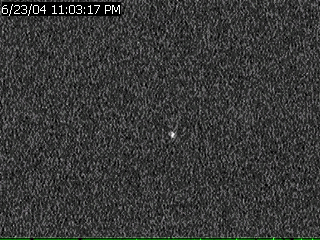
My plan was to use the video capture software to save images as an AVI movie, at a rate of 6 images per second; the software has the ability to add a timestamp to the corner of each image. However, when I tried taking a practice movie with about 15 minutes to go, the capture program crashed. It wouldn't restart until I rebooted the laptop. I tried a second time, decreasing the number of frames per second, but again the capture program crashed -- and again I had to reboot. There was no more time at this point for a THIRD reboot, so I swiched to a safer mode: capturing one frame per second as a JPEG image (with timestamp). This provides poor time resolution.
If I could do this over again, I would choose to send the video signal into an ordinary analog VCR instead, which would provide much finer time resolution.
We had to set the laptop's clock by hand, using another computer with accurate time as a reference. If I had practiced this the night before, I would have been able to get the missing Ethernet adapter for the laptop so that its clock could be set directly via a network connection. Sigh. We watched carefully after the occultation, comparing the laptop's clock to that of the other computer and to a WWV radio signal. It appears that the laptop's clock was very slightly slow, by 1/4 to 1/2 of a second. That means that the times you see in the pictures below are 1/4 to 1/2 of a second after the actual time.
We captured 330 images at a cadence of one per second. We saw the occultation occur on the laptop's screen at just about the predicted time for our location, which was about UT 03:03:15 = EDT 11:03:15.
I converted the JPEG images to FITS and then measured the instrumental magnitude of the target star+asteroid on the 100 images surrounding the event. I found that an aperture of radius 8 pixels gave a slightly smaller scatter from the mean than a radius of 6 pixels; that makes sense, as the messy stellar image was spread out quite a bit. Below is a graph of the instrumental magnitude as a function of image index number. The mean value is 17.41, with a scatter of 0.45 mag.
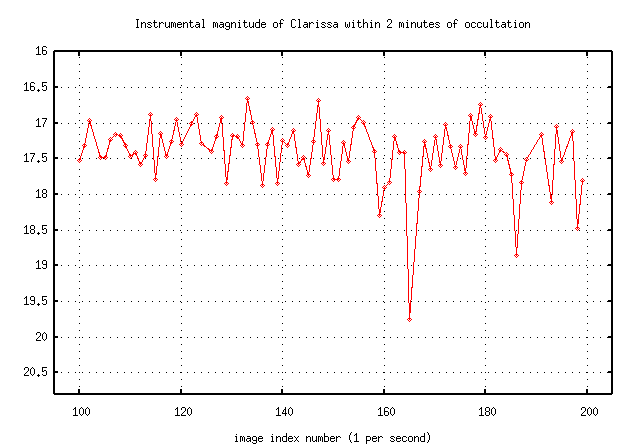
Here's a closeup showing the measured instrumental magnitudes on the frames closest to the occultation. The signal for image 165 is so faint that I don't believe it to be an accurate measure of the target star; you can judge for yourself in the pictures below.
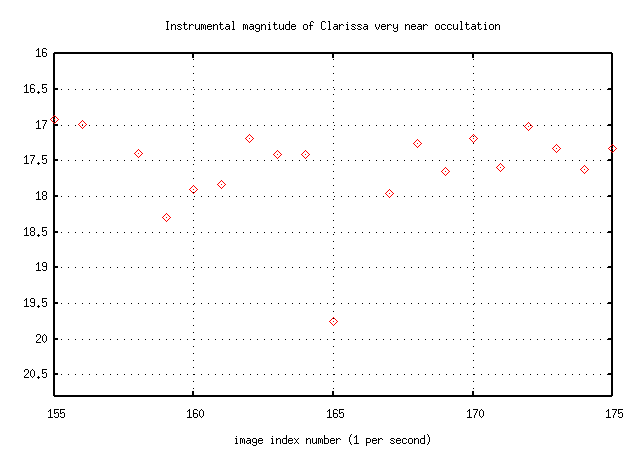
Here are the images for the few seconds surrounding the occultation. I have adjusted the contrast and brightness of each image manually to enhance the visibility of the star/asteroid image.
Images 163 and 164. Note 164 has the same time label!
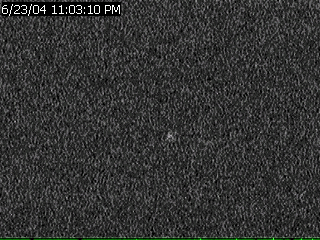
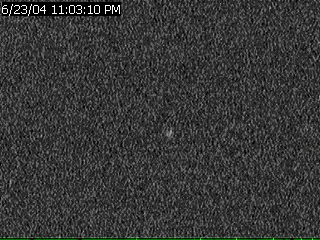
Images 165 and 166.
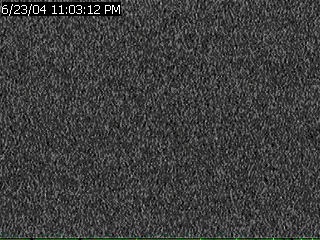
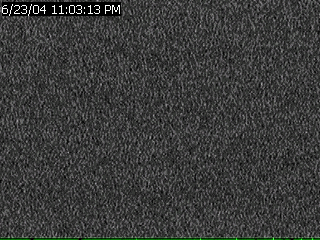
Images 167 and 168.
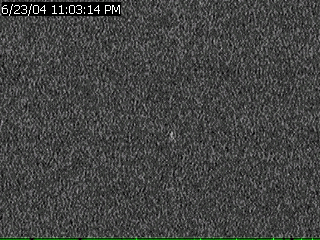
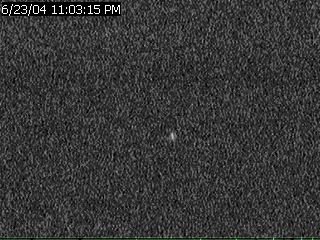
Images 169 and 170.
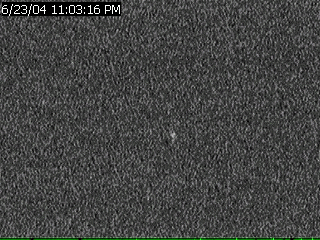

I also looked carefully at the images surrounding the other major drop in brightness during this 100-image sequence, which occurs at frame 186.
Images 184 and 185.
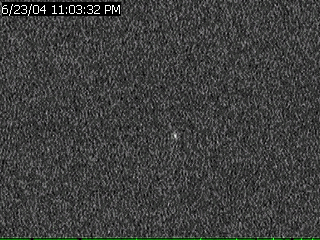
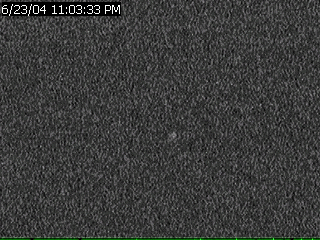
Images 186 and 187.
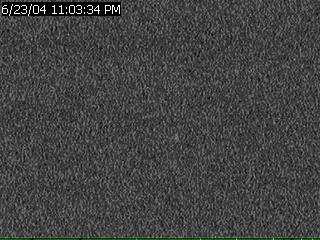
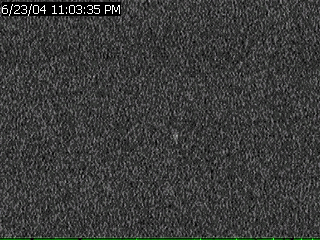
Images 188 and 189.
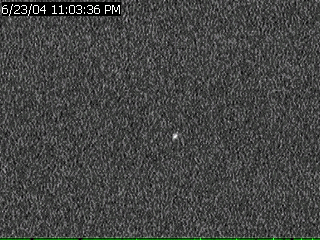
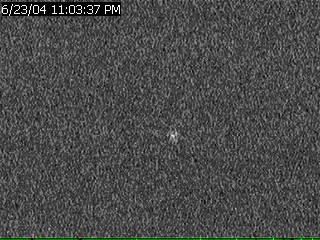
Based on the images we captured, I estimate that the asteroid occulted the target star
I realize that the time resolution of these measurements is poor. I will definitely choose a different method to record the information next time.
There is a hint of a smaller dimming of the target star about twenty seconds later, at UT 03:03:34, lasting for a second or two. I don't judge our images to be conclusive evidence of a real event, but mention it in case other observers have independent evidence for it.
David Dunham has been collecting reports from observers. A very early message, released the morning after the event, shows several positive results:
From the available observations, summarized below, the path apparently shifted just a little north of Steve Preston's prediction, with an error certainly less than 1/4th sigma. With durations longer than predicted, Clarissa seems to be larger than its expected diameter of 38 km. Occ'n Track Dur. Observer, location 163N miss Alan MacRobert, Bedford, MA 52N 0.25s Phil Dombrowski, Glastonbury, CT 42N -- predicted northern limit 16N 2-3s Michael Richmond, RIT Obs., Rochester, NY 17S 3.1s David Dunham, Walden, NY 25S 2.3s Frank Suits, Garrison, NY 42S -- predicted southern limit 54S miss Frank Melillo, Holtsville, L.I., NY
Please keep in mind that these are preliminary notes.
Here is a copy of my "IOTA asteroidal occultation report form", which I sent via E-mail to Jan Manek and David Dunham.
IOTA ASTEROIDAL OCCULTATION REPORT FORM
Asteroid (or other object): (302) Clarissa ___ Star:_ TYC 0272-00616-1 __ _
Date (U.T.):___June 24, 2004 _________ Predicted Time (U.T.):_ 03:03:16 ___
Observer Name:__ Michael Richmond _________ Telephone:__(585) 475-2538 ____
Postal Address:___ Physics Department, RIT, Rochester, NY, 14623 USA _______
E-mail Address:_ mwrsps@rit.edu ________________ Fax:___(585) 475-5766 ____
TELESCOPE: Aperture:_305 mm Focal length:_1920mm Type:__Schmidt-Cassegrain
Eyepiece Power:_video__ Observing site name: ___RIT Observatory _______
Longitude:____77:39:53 W _________ Latitude:____43:04:33 N ____________
Height above sealevel:_168 m_ How determined?:___topographic maps _____
Sky Transparency (Circle one, or delete two): Good
Star Image Stability ("seeing"; as above): Poor
Other Conditions: (Wind, Clouds, Lights, etc.):____________________________
EVENT TIMINGS: (All times in Universal Time)
Time Source:_ WWV _____ Recording method:_set comp clock, video capture__
Was the Asteroid Visible in your Scope? _no___ Approx. Limiting Mag.:_10?__
Universal Time Estimated Accuracy, Remarks
h m s Reaction
Time,
Started Observing: _03:_00:_00.___ (sec.) ____________________
Star and Object Merged: ___:___:___.___ ____________________
Disappearance: _03:_03:_11.8__ __.___ __+/- 0.5 __________
Estimated Closest Approach: ___:___:___.___ ____________________
(if no D/R)
Reappearance: _03:_03:_13.8__ __.___ __+/- 0.5___________
Star and Object Separated: ___:___:___.___ ____________________
Stopped Observing: _03:_06:_00.___ ____________________
Was your reaction time applied to the above timings? __no_____
If you could tell, did the object pass NORTH, SOUTH, EAST, or WEST of the
star (cicle one, or delete three)? If possible,
estimate the distance of closest approach in arc seconds: _______
List all Interruptions in Observing: Reason
From ___:___:___ to ___:___:___ __________________________________
From ___:___:___ to ___:___:___ __________________________________
Additional comments: ___captured video at one frame per sec, analyzed it ___
We got some surprises from the 2004 June 24th occultation of
SAO 118999 by (302) Clarissa! First, the predicted central duration
was only 1.8 seconds, but the two longest chords (confirmed video)
were just over 3.0 seconds long. Miss observations closely bound
the asteroid's shape on the north (Timerson) and south (Melillo).
My preliminary reduction (video times have so far only been
obtained manually, and so are accurate to about +/-0.2 second,
except for the Rochester observation, where the time resolution was
only +/-0.5 second) gives an ellipse 64 km long by 35 km wide,
considerably bigger than the expected diameter of 38 km. The motion
was almost in the direction of the major axis. A plot of the
observations produced with Occult is attached. For Dave Herald's
benefit, I have also attached the Occult input .OBS file.
But the biggest surprise is Phil Dombrowski's short event
(station 4). I thought that it must mark the northern limit, but
Brad Timerson, farther south, reported a miss, and he was confident
that he had the right star on his video. The analysis showed the
truth - Dombrowski's event doesn't match the others at all! We need
to double-check everything, but it appears, that if Dombrowski's
event is a real occultation, it was caused by a satellite of
Clarissa about 258 km in the sky plane (4 times the major axis) from
the center of Clarissa. Dombrowksi's duration of about a quarter
second would indicate an object of the order of 5 - 6 km in size.
You must use a fixed-space font such as Courier to display the
table of observations below properly.
Sta. Observer name, location E.Longitude Latitude height
# o ' " o ' " m
1 David Dunham, Walden, NY -741207.6 +413218.9 133
2 Frank Suits, Garrison, NY -735459.5 +4123 4.7 203
3 Michael Richmond, RochesterIT Obs, NY -773953. +430433. 168
4 Phil Dombrowski, Glastonbury, CT -723445.1 +414334.8 46
5 Brad Timerson, Newark, NY -77 537.4 +43 210.1 144
6 Predication, Steve Preston, June 20 -74 0 0. +413847. 0
7 Frank Melillo, Holtsville Long Is, NY -73 231.2 +404836.0 0
Universal Times
Sta. Observer name Disappear Reappear
# h m s h m s
1 David Dunham D 3 323.2 3 326.3
2 Frank Suits D 3 324.57 3 327.60
3 Michael RichmondD 3 311.8 3 313.8
4 Phil Dombrowski D 3 336.9 3 337.15
5 Brad Timerson M 3 313.9 3 313.9 miss; closest approach time
6 Predication P 3 327. 3 327. predicted time
7 Frank Melillo M 3 329.9 3 329.9 miss; closest approach time
David Dunham, 2004 June 27
Update July 31, 2004: Sky and Telescope's article about the Clarissa occultation says that
William J. Merline (Southwest Research Institute) will attempt to observe the asteroid with the European Southern Observatory's 8.2-meter Very Large Telescope in Chile. Using adaptive optics, Merline will have the necessary resolution to obtain direct observational evidence of the moonlet.